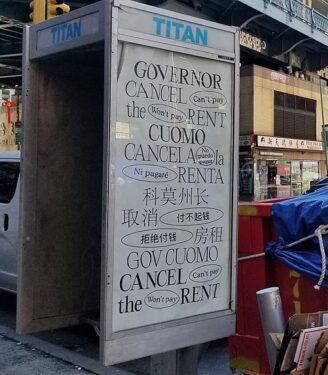
CARROLL GARDENS — Unpaid rent in New York City, estimated at $1-to-2 billion, could cause a serious ripple effect, and landlords say they fear having to absorb most of it.
Federal and state governments, including New York, have acted to help tenants avoid evictions since the coronavirus arrived in the U.S. one year ago.
Former President Donald Trump and Gov. Andrew Cuomo ordered temporary eviction moratoriums. President Joe Biden has also extended federal aid to states to help their residents struggling with unemployment.
But landlords, and groups that represent them, say the measures should have done more for the property owners, which could have been a more efficient way of shoring up the economy.
“A lot of landlords are hurting,” said Deb Scotto, who owns rental property in Carroll Gardens. “A lot of real estate taxes are going unpaid with no abatement, insurance prices are through the roof, and water and sewer keep going up.”
Scotto noted that the pandemic has forced “a mass exodus out of the city.” A glut of vacancies that don’t generate any income persisted for a while, but that is starting to reverse, she explained.
Still, the eviction moratoriums limit what landlords can do to keep their rental businesses going.
“People are struggling right now, and I get that,” Scotto said. “I don’t want to see homelessness explode and have people thrown out onto the street. But no one is helping the landlords.”
Scotto said it takes longer for the economic consequences to be felt, such as foreclosures and government revenue lost because of unpaid property taxes.
“It’s going to be an avalanche,” she said. “And it’s grossly unfair.”
The Biden administration has said one in five U.S. households that rent are behind on their payments. Included in that number are about 1.3 million residents of New York state according to data from the Center on Budget and Policy Priorities.
In New York City, unpaid rent is at least $1 billion, according to a survey conducted by the landlord trade group, Community Housing Improvement Program (CHIP).
After canvassing landlords, the group found that about 185,000 households were behind on rent by two months or more and the average debt per household was more than $6,000.
These figures focus on buildings subject to NYC rent-regulation laws, explained Jay Martin, CHIP’s executive director. He has said that debt from the rest of the city’s rental stock adds at least another $1 billion to the actual total.
Landlord advocates say state and federal governments should have made rental assistance money available soon after the pandemic arrived. That way tenants would have had a better chance to stay current and landlords would have been spared consequences of the lost income.
There may finally be some relief on the way for landlords to mitigate their problems.
In December, Congress passed COVID-relief legislation that funds $25 billion for a new Emergency Rental Assistance Program (ERAP). The Treasury Department is divvying up the money to the nation’s states, territories, Native American tribes, and large municipalities.
In turn, eligible households may receive up to 12 months of assistance, plus an additional three months if necessary, according to the Treasury. The money covers rental payments and arrears beginning March 13, 2020, which is around when the pandemic hit the country.
New York has received $1.3 billion of the funds and the job of allocating the money went to the state’s Office of Temporary and Disability Assistance. That office has announced it is developing an online portal for people or landlords to apply for the aid, but gave no indication when that would be available. A Feb. 19 advisory said more information would be released soon.
Landlords would benefit because the money is to be paid directly to them on behalf of the renter. Scotto said that is one positive aspect for the property owners.
“That’s actually better,” Scotto said. “Otherwise I could see a lot of playing around there.”
Scotto helps run her family’s business, Scotto Funeral Home, with her cousin, John L. Heyer Jr. She described her personal rental properties as a “mix.”
“We have all different kinds of stuff, from small one beds, lofts, and multi beds, and duplexes,” she said.
For Scotto, the most challenging part of being a landlord during the pandemic was the vacancies that lasted longer than usual — a few weeks or even a month.
“We used to have tenants immediately take our vacant units,” she said.
However, she added that with so many empty units on the market, potential tenants had the luxury of “shopping around.” Apartment buildings without laundry facilities or open spaces seemed to stay available longer, Scotto said.
She also explained that some of her vacancies occurred when tenants lost their jobs in the pandemic, and she agreed to cancel their leases. She said that allowed tenants to find better arrangements for themselves.
“Then you risk a vacancy,” Scotto said. “But for me, it was just easier to work with the tenants.”
